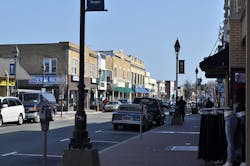Downtown Freeport, NY. Credit Joe Mabel
Freeport, a village in New York, hopes to bring greater electric reliability to homes, businesses and critical facilities with a $35 million community microgrid.
The Long Island community has proposed the project as part of NY Prize, a state-sponsored competition to encourage microgrid development.
The downtown microgrid would serve 106 residences, 81 commercial facilities, a police station, three firehouses, four healthcare providers, three water treatment facilities, and schools and a recreational center that serve as emergency shelters.
Part of the town of Hempstead, Freeport is located in Nassau County on the south shore of Long Island, an area hard hit by both Hurricane Irene and Superstorm Sandy. More than 4,000 of Freeport’s multi-family housing units and 130 of its homes were deemed unsafe for habitation after Sandy, according to the project feasibility study submitted to NY Prize.
Freeport Electric, the municipal utility that serves the area, operates two power plants that can maintain services to the area if it loses its connection to the central Long Island grid. However, if it loses one plant (Power Plant 2), then it must shed load or implement rolling blackouts. In this contingency, the proposed microgrid would provide continuous power to the downtown area, which houses many of its critical public services.
Distributed energy
The microgrid would augment or replace aging diesel engines at the town utility’s Power Plant 1 (PP1) substation with two 4.44 MW dual-fuel natural gas reciprocating engine generators that have black start (emergency startup) capability. In addition, the project can add a layer of redundancy to the Freeport PP1 distribution system by creating a downtown 3-Phase, 13.8kV circuit with spurs to emergency facilities.
Other distributed energy planned includes: 1.33 MW of solar, battery storage, and possibly 1 megawatt of wind power.
Many microgrids use combined heat and power (CHP), and Freeport considered the option. But the village found that CHP is not feasible due to the existing land use and density surrounding the new generation and a lack of existing centralized heating and cooling infrastructure.
Microgrid intelligence
The project includes sophisticated controls, often described as the brains or software intelligence of the system. Provided by S&C Electric and Schneider Electric, the controls would allow the microgrid to feed power into the grid during normal operation, and to maintain power to the downtown during utility outages.
With these controls, the microgrid can not only bolster reliability but also create several potential revenue opportunities for Freeport, including wholesale energy and capacity payments, energy sales, and premiums from new customers that may seek out connection to the microgrid. (For example, data centers, research facilities and businesses dependent on high quality power are often willing to pay a premium for microgrid service.)
In addition, the community microgrid could offer ways for Freeport to reduce energy costs:
- By saving peak demand through use of the battery
- By producing lower cost energy with renewables
- By decreasing energy demand, and therefore need for fuel, through use of advanced metering infrastructure.
Freeport Electric also may use the microgrid to avoid expensive wholesale power purchases during peak periods. In fact, the microgrid may be able dispatch its cheaper power to the wholesale grid during these periods, if the town does not need the electricity.
Another advantage of the Freeport microgrid is its flexible design. This will allow the community microgrid to scale up to meet the demands of future load growth over the next 20 years.
The project partners are Village of Freeport, Freeport Electric, Anbaric, Arup, and National Grid, according to the NY Prize website.
The source of this information is the NY Prize Feasibility Studies, NYSERDA and NY Prize Stage 1 Winner.
Read about more projects like this on the Microgrid Knowledge Community Microgrid Channel.
[clickToTweet tweet=”Out of Disaster Comes a #Microgrid & Opportunity in Freeport, NY @SandC_US” quote=”Out of Disaster Comes a Microgrid & Opportunity in Freeport, NY “]







